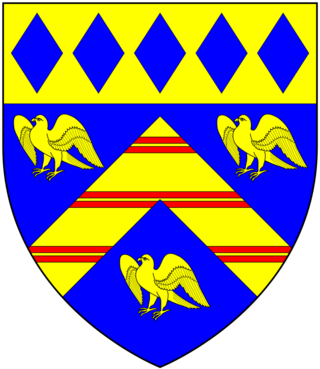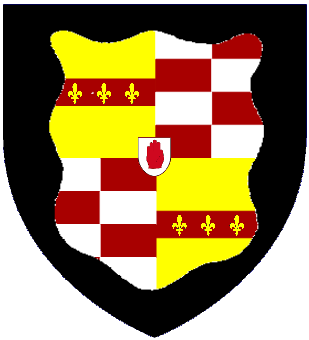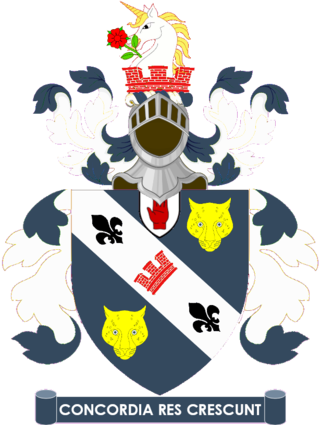
Baron Roborough, of Maristow in the County of Devon, is a title in the Peerage of the United Kingdom. It was created on 24 January 1938 for Sir Henry Lopes, 4th Baronet. He had earlier represented Grantham, Lincolnshire, in Parliament as a Conservative. The Baronetcy, of Maristow House in the County of Devon, had been created in the Baronetage of the United Kingdom on 1 November 1805 for Manasseh Masseh Lopes, a member of a wealthy family of Portuguese Jewish origin, with special remainder to his nephew Ralph Franco, son of his sister Maria. Manasseh Masseh Lopes converted to Christianity in 1802, and later represented Evesham, in Worcestershire, Barnstaple in Devon, and Westbury in Somerset, in Parliament. However, in 1819 he was twice convicted of bribing the voters in both Barnstaple and Grampound in order to be elected to Parliament, and was sentenced to imprisonment and heavy fines. He was also unseated by the House of Commons, but after his release from prison he nonetheless got elected for Westbury, a pocket borough which he controlled to a great extent.

The Hobhouse Baronetcy, of Chantry House in the parish of Bradford-on-Avon in the County of Wiltshire and of Westbury College in the County of Gloucester, is a title in the Baronetage of the United Kingdom. It was created on 22 December 1812 for Benjamin Hobhouse, a wealthy brewer and member of parliament for Bletchingley, Grampound and Hendon. His eldest son, the second Baronet, was a prominent writer and Liberal politician and notably served as Chief Secretary for Ireland and as President of the Board of Control. In 1851 he was raised to the peerage as Baron Broughton, of Broughton-de-Gyffard in the County of Wiltshire. However, he had no sons and on his death the barony became extinct, while he was succeeded in the baronetcy by his nephew, the third Baronet. The latter's son, the fourth Baronet, was also a noted Liberal politician and held office as Chancellor of the Duchy of Lancaster and as Postmaster General.

The Macartney Baronetcy, of Lish in the County of Armagh, is a title in the Baronetage of Ireland. It was created on 4 January 1799 for Sir John Macartney, Member of the Irish House of Commons for Fore and Naas. He had been knighted in 1796 for promoting inland navigation in Ireland. Macartney was the younger son of William Macartney, who represented Belfast in the Irish Parliament. The family have lived in Australia since the emigration of the third Baronet in the 19th century.

The Anson baronetcy, of Birch Hall in the County Palatine of Lancaster, is a title in the Baronetage of the United Kingdom held by a branch of the Anson family.

The Barrett-Lennard Baronetcy, of Belhus in the County of Essex, is a title in the Baronetage of the United Kingdom. It was created on 30 June 1801 for Thomas Barrett-Lennard, subsequently Member of Parliament for Essex South. He was the illegitimate son and testamentary heir of Thomas Barrett-Lennard, 17th Baron Dacre. He was succeeded by his grandson, the second Baronet, the son of Thomas Barrett-Lennard, Member of Parliament for Maldon. His son, the third Baronet, was childless and was succeeded by his younger brother, the fourth Baronet. This line of the family failed on the death in 1977 of his son, the fifth Baronet, who died without male issue. The late Baronet was succeeded by his third cousin once removed, the sixth Baronet. He was the son of Sir Fiennes Cecil Arthur Barrett-Lennard, Chief Justice of Jamaica, son of Captain Thomas George Barrett-Lennard, son of the first marriage of George Barrett-Lennard, son of John Barrett-Lennard, second son of the first Baronet. The sixth Baronet was a Catholic clergyman. As of 2014 the title is held by his second cousin, the seventh Baronet, who succeeded in 2007. He is the grandson of Trenchard Barrett-Lennard, son of the aforementioned George Lennard-Barrett by his second marriage. As of 31 December 2013 the present Baronet has not successfully proven his succession and is therefore not on the Official Roll of the Baronetage, with the baronetcy considered vacant since 2007.
The Broadhead, later Brinckman Baronetcy, of Burton or Monk Bretton in the County of York, is a title in the Baronetage of the United Kingdom. It was created on 30 September 1831 for Theodore Broadhead, Member of Parliament for Yarmouth. In 1842 he resumed by Royal Licence the old family surname of Brinckman in lieu of his patronymic. Brinckman was the son of Theodore Broadhead, who also represented Yarmouth in the House of Commons, son of Theodore Broadhead, High Sheriff of Surrey in 1786, who assumed the surname of Broadhead in lieu of Brinckman by Act of Parliament. The latter's grandfather Theodore, Baron Brinckman, had emigrated to Britain from Hanover. The first Baronet was succeeded by his eldest son, the second Baronet. He sat as Liberal Member of Parliament for Canterbury. His grandson, the fourth Baronet died childless in 1954 and was succeeded by his younger brother, the fifth Baronet. The latter was a colonel in the Grenadier Guards, Aide-de-Camp to the Governor of Victoria and to the Governor-General of Canada and Chief of Staff to the British Military Mission in Moscow during the Second World War.

The Blennerhassett Baronetcy of Blennerville in the County of Kerry, is a title in the Baronetage of the United Kingdom. It was created on 22 September 1809 for the Anglo-Irish lawyer Rowland Blennerhassett, He was from a family originally from Cumberland, England, that settled in County Kerry during the reign of James I and represented County Kerry and Tralee in the Irish House of Commons.

The Bromhead Baronetcy, of Thurlby Hall in the County of Lincoln, is a title in the Baronetage of the United Kingdom. It was created on 19 February 1806 for the soldier Lieutenant-General Gonville Bromhead. His eldest son, the second Baronet, was a mathematician. He died unmarried and was succeeded by his younger brother, the third Baronet. He was a Major in the Army and fought at the Battle of Waterloo. His eldest son, the fourth Baronet, was a Colonel in the Indian Staff Corps. He was succeeded by his grandson, the fifth Baronet. He was a Lieutenant-Colonel in the Indian Army. As of 2007 the title is held by his son, the sixth Baronet, who succeeded in 1981. However he does not use his title.
The Hartwell Baronetcy, of Dale Hall in the County of Essex, is a title in the Baronetage of the United Kingdom. It was created on 26 October 1805 for Admiral Francis Hartwell.

The Price, later Rugge-Price Baronetcy, of Spring Grove in Richmond in the County of Surrey, is a title in the Baronetage of the United Kingdom. It was created on 2 February 1804 for Charles Price, Member of Parliament for the City of London from 1802 to 1812 and Lord Mayor of London from 1802 to 1803. The fifth Baronet assumed in 1874 by Royal licence the additional surname of Rugge. As of 28 February 2014 the present Baronet has not successfully proven his succession and is therefore not on the Official Roll of the Baronetage, with the baronetcy considered dormant since 2000.

The Wraxall Baronetcy, of Wraxall in the County of Somerset, is a title in the Baronetage of the United Kingdom. It was created on 21 December 1813 for Nathaniel Wraxall. He was in the East India Company Civil Service, an author and member of parliament for Hindon, Ludgershall and Wallingford. His grandson, the third Baronet, was an author.

The Rycroft Baronetcy, of Calton in the County of York, is a title in the Baronetage of Great Britain. It was created on 22 January 1784 for Reverend Richard Rycroft. Born Richard Nelson, he was the only surviving son of John Nelson, and had assumed by Royal sign-manual the surname of Rycroft in lieu of his patronymic in 1758. The fifth Baronet was high sheriff of Hampshire in 1899. The sixth Baronet was high sheriff of Hampshire in 1938.
The High Sheriff of Limerick was the British Crown's judicial representative in County Limerick, Ireland from the 13th century until 1922, when the office was abolished in the new Free State and replaced by the office of Limerick County Sheriff. The sheriff had judicial, electoral, ceremonial and administrative functions and executed High Court Writs. In 1908, an Order in Council made the Lord-Lieutenant the Sovereign's prime representative in a county and reduced the High Sheriff's precedence. However, the sheriff retained his responsibilities for the preservation of law and order in the county. The usual procedure for appointing the sheriff from 1660 onwards was that three persons were nominated at the beginning of each year from the county and the Lord Lieutenant then appointed his choice as High Sheriff for the remainder of the year. Often the other nominees were appointed as under-sheriffs. Sometimes a sheriff did not fulfil his entire term through death or other event and another sheriff was then appointed for the remainder of the year. The dates given hereunder are the dates of appointment. All addresses are in County Limerick unless stated otherwise.
The Sullivan baronetcy, of Thames Ditton in the County of Surrey, was created in the Baronetage of the United Kingdom on 22 May 1804 for the writer and MP Richard Sullivan. The third and sixth Baronets were Admirals in the Royal Navy. The ninth holder of the baronetcy did not use his title; as of 2023 the Official Roll marked the baronetcy as vacant.

The Clarke Baronetcy, of Dunham Lodge in the County of Norfolk, was created in the Baronetage of the United Kingdom on 30 September 1831 for Charles Clarke, Physician to Queen Adelaide. The third Baronet was a prominent soldier. The sixth Baronet adopted the additional Christian name of Tobias in 1962. The current baronet, Sir Lawrence Clarke, was selected for Great Britain in the XXX Olympiad in London in 2012 for the 110m hurdles.

The Baird baronetcy of Newbyth, second creation, in the County of Haddington, was created in the Baronetage of the United Kingdom on 13 April 1809 for the soldier David Baird, grandson of William Baird, a younger son of Sir Robert Baird, 1st Baronet, of Saughtonhall. His father, William Baird, had inherited the Newbyth estate in 1745 on the death of Sir John Baird, 2nd Baronet, of the 1680 creation. The baronetcy was created with remainder to Baird's elder brother Robert Baird and the heirs male of his body. Sir David Baird died childless and was succeeded, according to the special remainder by his nephew David Baird, the second Baronet. At the death of the 6th Baronet in 2022, his fourth cousin, Sir Andrew James Baird became the 7th Baronet in April 2023.
The Falkiner baronetcy, of Anne Mount (Glounthaune), in the County of Cork, was created in the Baronetage of Ireland on 24 August 1778 for Sir Riggs Falkiner, 1st Baronet. He represented Clonakilty in the Irish House of Commons.

The Jackson baronetcy, of Arlsey in the County of Bedford, was created in the Baronetage of the United Kingdom on 22 May 1815 for John Jackson. He was a Director of the Honourable East India Company and also represented Dover in the House of Commons.

The Simeon baronetcy, of Grazeley in the County of Berkshire, was created in the Baronetage of the United Kingdom on 22 May 1815 for John Simeon, Member of Parliament for Reading and Senior Master of the Court of Chancery. The evangelical cleric Charles Simeon was his brother.

The Chaytor baronetcy, of Croft in the County of York and of Witton Castle in the County of Durham, was created in the Baronetage of the United Kingdom on 30 September 1831 for William Chaytor, an industrialist and Whig politician who served as MP for Richmond in the first Reform Parliament. He built Clervaux Castle on the manor of Croft. He was son of William Chaytor of Croft and Spenningthorne, Member of Parliament for Hedon ; his great-grandfather, Henry Chaytor was brother to Sir William Chaytor, 1st Baronet of the first creation.















